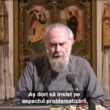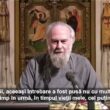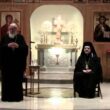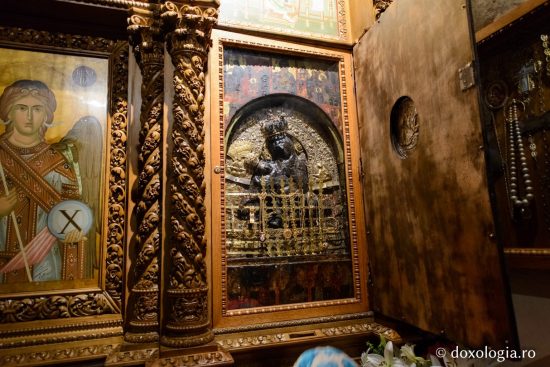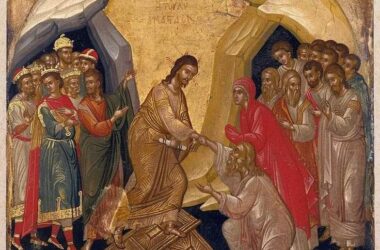The blackened Icon is a wax bas-relief, approximately 45 square centimeters in size, depicting the Mother of God slightly turned to the right, holding her divine Son in her arms. With her left hand, she holds the hand of the Child to her chest, while in the right hand of the Son, there is the Holy Gospel. In the corners, Cherubim and Seraphim are depicted.
The tradition of the Mega Spileo Monastery suggests that this Icon is believed to be one of the first Icons painted by Saint Luke the Evangelist. It is said that when he depicted it to the Virgin Mary, she uttered the words, “May the gift of the One who was born from me be with it!” Later, Saint Luke presented this Icon, along with his Gospel and the Acts of the Apostles, to his spiritual son Theophilus, the governor of Achaia.
During the Roman persecution, when many of the early Christians were martyred, the Icon was hidden in a cave, where it remained until it was miraculously discovered by Saint Euphrosyne.
Young Euphrosyne was from the nearby village of Galata (now Zachlarou) and often grazed her father’s flock near a tall rock. Twice she saw one of the goats climbing to the mouth of a cave in the rock and returning with its mouth full of water. Suspecting that there was a spring with cold water there, she climbed up to take a look. After making her way through the dense bushes, she found herself at the entrance of a very large cave. Suddenly, she heard a voice calling her by name.
Looking around, she saw an Icon of the Mother of God at the top of the cave wall, and from the Icon, she heard a voice telling her to wait for the arrival of the monks Simeon and Theodor.
At that time, while they were in Jerusalem, the two young monks, Simeon and Theodor, had the same dream in which the Mother of God, accompanied by the Holy Apostles Paul, Andrew, and Luke, commanded them to go to Achaia to find an Icon carved there by Saint Luke. Having received the blessing of the bishop, they set off for the northeastern coast of the Peloponnese.
Upon arriving in Achaia, the Venerable Simeon and Theodor prayed once again for guidance, and that night they had another dream in which they were told to go to the Bouras River, two hours away, where they would find a devout shepherdess named Euphrosyne, who would lead them to the Icon. The next morning, as they approached the sought-after location, they found the shepherdess waiting for them.
She blessed them and called them by name. Frightened by her spiritual vision, the monks hesitated to approach, but seeing their doubt, Euphrosyne called upon the name of the Mother of God and struck the rock on which she stood with her staff, causing a spring of clear and sweet water to gush forth. This spring continues to exist to this day and bears the name of Euphrosyne.
After Euphrosyne recounted how she discovered the Icon of the Mother of God, the monks ascended to the cave and found everything just as Euphrosyne had described. They carefully lowered the Icon, brought it outside, and returned to clean the cave. After lighting a fire to burn the bushes and debris, they waited outside for the flames to die down. Suddenly, a gigantic snake, driven out by the smoke, slithered out of the cave as if it had wings. As the monks and Euphrosyne moved aside to avoid it, a bright lightning bolt emerged from the Icon and struck the snake to the ground. They entered the cave again and found a table where, according to the tradition of the monastery, the Evangelist Luke celebrated the Divine Liturgy and wrote the Holy Gospel. Later, they expanded the cave and erected a small chapel and several cells around it.
The news of the discovery of the Icon quickly spread throughout the entire Peloponnese, and many faithful people came to venerate the Icon through which God performed numerous miracles. Other monks also gathered around them, and Fathers Simeon and Theodor began to travel throughout the Peloponnese, preaching and calling people to return to Christianity. They were briefly expelled from this land during the reign of the apostate Emperor Julian but returned shortly after his death. Both monks eventually passed away at Mega Spileo. Euphrosyne built a small hermitage near the cave and lived a solitary life there until her death.
Over time, many miracles and healings have taken place through the mediation of the Icon of the Mother of God from Mega Spileo. Since its foundation in the 4th century, the monastery has experienced five devastating fires. Each time, miraculously, the Icon from Mega Spileo was saved from destruction.
The Icon of the Mother of God from Mega Spileo is celebrated on August 23rd, which is the conclusion of the feast of the Dormition of the Theotokos.
Rev Silviu Cluci
Source: http://doxologia.ro

